Vortex Of Energy
“I believe matter itself is just spin.” ~ Eric Laithwaite
Indian mystics in the pre-scientific era were able to probe the atom with supernormal powers. The first authoritative and systematic exposition of this practice by Yogis was written about 400 B.C. in the ‘Sutras of Patanjali’ where the physiological and psychological results of meditation were described in detail. In Aphorism 3.26 it states: pravrtty-aloka-nyasat suksma-vyavahita-viprakrsta-jnanam e.g. knowledge of the small, the hidden and the distant can be acquired by directing the light of super-physical faculties called in Sanskrit siddhis. The ability to perceive the small, the distant and the hidden is called the anima siddhi which is developed in the practice of advanced yoga.1, 2
In an altered state of consciousness the Yogi exercising the siddhi could experience visual images of objects too small for human sight to discern. The experience was of shrinking consciousness commensurate to the size of the objects being viewed. Through exercise of the anima siddhi, yogis perceived the smallest particles in matter as vortices of energy.
With the anima siddhi, Yogis in ancient India saw quantum spin setting up fundamental particles of matter and giving rise to the properties we treat as material. They realised vortex motion was the source of the illusion of the material world which they called Maya. From their insight into the atom Yogis knew that people who believed the material world to be real were deluded; they were hoodwinked by spin.
The delusion of materialism in Western thinking can be traced back to the Greek philosophers, especially Democritus who suggested the atom as the fundamental particle of matter. Opposed to the mystical traditions of ancient Egypt and Greece, Democritus contended that: “Only atoms in space exist; everything else is opinion.”
Modern physics has exposed that as opinion and exploded his myth of materialism. While upholding the particulate nature of fundamental particles, the ‘Atomic Hypothesis’ of Democritus, the bedrock of classical scientific materialism was disproved by Albert Einstein. Now it has become generally accepted in modern science that only energy exists and energy gives rise to atoms and space.
Yogis anticipated Einstein. Millennia before him they appreciated that matter was a form of energy. Toward the end of the 19th century, the Indian Yogi Ramacharaka ran a series of lessons in Yogic Philosophy. The lesson notes were subsequently published in the 1930’s by Fowler. In ‘An Advanced Course in Yogi Philosophy’, Yogi Ramacharaka, referring to Lord Kelvin’s theory of the vortex atom, pointed out that thousands of years previously yogis had recognised that energy – prana – exists in matter – akasa – in the form of vortices – vritta. 3
Lord Kelvin was a towering genius of 19th Century classical physics. He pioneered thermodynamics – the science of energy. In Kelvin and Ramacharaka’s day the atom was thought to be the smallest particle of matter. Kelvin despised the common assumption that atoms were material particles like billiard balls. To him this model was completely unsatisfactory as it offered no explanation for the properties of matter. He considered the popular, materialistic view of matter was superficial and naive and dismissed it, describing the billiard ball atom as ‘’…the monstrous assumption of infinitely strong and infinitely rigid pieces of matter… Lucretius’s atom does not explain any of the properties of matter…’’ 4
In the Victorian era people believed the Universe was pervaded by the luminiferous ether which transmitted waves of light much as the ocean transmits water-waves. Like most scientists, Kelvin believed that light consisted of wave motion in the ether. His addition to the theory was the idea that atoms were vortices in the ether.
Though Kelvin’s theory of the vortex atom has been discarded now, his suggestion that light and matter can be reduced to two fundamental forms of motion – waves and vortices – was profound and accepted by his contemporaries.
Leading Victorian scientists believed in the vortex atom. As a theory for matter the vortex dominated physics in the latter half of the 19th Century and continued to be taught at Cambridge until 1910. James Clerk Maxwell, who developed electromagnetic theory, was a major proponent for the vortex idea. In the Encyclopedia Britannica of 1875 he wrote ‘’…the vortex ring of Helmholtz, imagined as the true form of the atom by Thomson (Lord Kelvin), satisfies more of the conditions than any atom hitherto imagined …’’. 5
J. J. Thomson, discoverer of the electron and professor of physics at the Cavendish Laboratory of Cambridge, said that the vortex theory: “…has a priori very strong recommendations in its favour… the vortex theory for matter is of a much more fundamental character than the ordinary solid particle theory.” 6
With the vortex atom, Victorian scientists were able to reduce the properties of matter to a single, underlying and unifying principle. As such they were moving toward a unified field theory. But the Victorian vortex theory failed on two counts. Firstly it was applied to the atom which is not a fundamental particle and so it was unable to account for new properties of the atom, like spectral lines. Secondly it was assumed the vortices were in the ether. When the ether theory was disproved and disbanded all the ether theories, including the vortex, were abandoned.
Yogis in ancient India said the smallest particles of matter were vortices of prana – their word for energy. They never assumed the existence of the ether nor recorded complex atoms. The vortex idea from Yogic philosophy is a working model whereas the Vortex atom from Victorian physics is not. The Yogic mystical insight suggests that subatomic particles are vortices of energy. That could turn out to be the single most powerful idea in the history of science.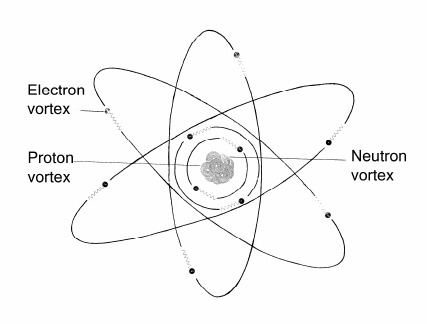 In 1919 two momentous events occurred in physics. Lord Rutherford performed experiments that led to the discovery of the proton and Albert Einstein’s theories became generally accepted. Although Einstein first published his famous equation E=mc2 in 1905 it was 1945 when the shattering implications of his discovery, that matter is a form of energy, really sunk home.
In 1919 two momentous events occurred in physics. Lord Rutherford performed experiments that led to the discovery of the proton and Albert Einstein’s theories became generally accepted. Although Einstein first published his famous equation E=mc2 in 1905 it was 1945 when the shattering implications of his discovery, that matter is a form of energy, really sunk home.
However, when Albert Einstein was still at school Yogi Ramacharaka was teaching that matter is a form of energy. He described how energy forms mass when generally today that is a mystery. $8 billion has been spent on the Large Hadron Collider in Switzerland with an objective to solve the mystery. At CERN physicists believe they have discovered ‘Higgs Boson’ but when Yogis penetrated the atom with ‘mind-over-matter’ they didn’t see Higg’s boson, they saw spin! They saw a vortex of energy forming mass. Yogis in loin cloths probing matter with their siddhi powers didn’t need hideously expensive particle accelerators. They described mass as spin from direct observation.
One of the problems with the word ‘vortex’ is that it conjures up the conical spin of a tornado or hurricane, water swirling down the plug hole in a bath or a torroid smoke ring. However, ‘vortex’ applies to any ‘dynamic three dimensional spiral’ and there are many forms of these. One is a ball of wool. When someone winds wool onto a ball or knits from it, the ball is growing or shrinking. Then it is a vortex. Imagine energy as wool. If it spins about a single point it will be free to spin in every direction so it will form a ball. There is no reason for it to form a toroidal vortex as depicted by the Victorian scientists. It would form a corpuscular or spherical vortex because of its freedom to spin on infinite axes, in infinite planes.
A conical vortex spins about an axis so it has poles. A spherical vortex is a perfect sphere without a discernable axis of spin or measurable poles because they are changing all the time. If the spherical vortex is a vortex of energy they will be changing at the speed of light; too fast to catch the spin at any moment in any direction!
The subatomic spherical vortex of energy provides a perfect model for the corpuscular particle of matter. Most vortex models for atoms and subatomic particles – like Lord Kelvin’s torroid vortex – fall at the first hurdle because subatomic particles are perfect spheres without any discernable axis or poles. For a model to work in physics it has to satisfy all the experimental observations that apply to it. The ‘ball of wool’ model is very powerful because it works well with experimental physics.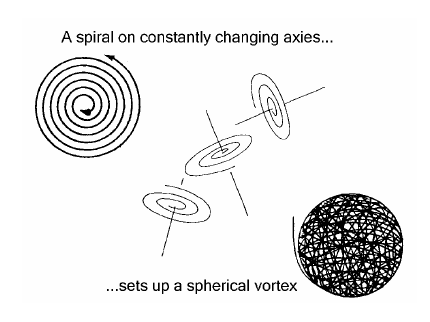 The spherical vortex of energy could form the corpuscular electron, proton and neutron particles that make up the atom. One property of particles of matter is inertia. Richard Feynman, one of the greatest physicists of the 20th century, said that: “The laws of inertia have no known origin.” 7
The spherical vortex of energy could form the corpuscular electron, proton and neutron particles that make up the atom. One property of particles of matter is inertia. Richard Feynman, one of the greatest physicists of the 20th century, said that: “The laws of inertia have no known origin.” 7
The vortex of energy begins to show its potential by providing a very simple and straightforward account for inertia. Spin sets up inertia. The inertia is in the plane of the spin. This is illustrated by the gyroscope. A gyroscope is a horizontal spinning flywheel. On a ship a massive gyroscope acts against the list and pitch of the ship in an angry sea to help keep the ship level. A spinning pebble skipping across the surface of a pond also illustrates the inertia of spin. It is the spin of the pebble, which keeps it in the plane in which it is thrown so that it skims rather than sinks.
In a spherical vortex the simultaneous spin of energy in all directions would set up an inertia or resistance to movement of the vortex in any direction. This is how the subatomic vortex sets up the inertia of mass.
Energy is motion. Motion creates inertia. This is illustrated by balance on a bicycle or skis. The forward motion on skis or bicycles set up resistance to sideways movement out of the plane of motion. So it is in the atom, the spin of electrons and their motion in orbits contributes to the inertia of the atom. Albert Einstein’s original paper equating energy with mass did so in terms of the inertia. Einstein had the 8 E=mc2 equation in that epoch making paper; all he lacked was the visual image of the spherical vortex to bring the understanding of energy, inertia and mass into the realm of common appreciation.
Thanks to the mystic view of the subatomic vortex of energy we can begin to appreciate the Yogic concept of ‘maya’; the illusion of material. Spin energy sets up the illusion of ‘static inertia’ characteristic of atoms. Democritus was deluded by maya as were many of the Greek philosophers. They didn’t have the siddhi powers of Yogis. They had nothing but the speculative imagination of the mind which, as we all know, is liable to lead us astray. Lord Kelvin had a profound mind. He was right when he described classical materialism as a monstrous assumption. He realised the concept of material with irreducible properties was a delusion set up by vortex motion. The inertia of mass is a fundamental property of matter explained by the vortex of energy. Kick a rock and you will find this hard to believe but it is an illusion!
To appreciate that mass originates from motion imagine rain in the Swiss Alps. As the water falls to form streams tumbling down the mountains, these join the torrent of rivers that pass through hydroelectric plants. There the fall of the water is converted into the spin of the turbine and then the flow of electricity. The electricity is fed into CERN, the European particle accelerator where it is used to accelerate protons. As the protons collide in the intersecting rings of this high-energy physics laboratory, their motion is arrested. The arrested kinetic energy is transformed into the mass of newly created particles.
Is anyone going to suggest that in the fall of rain, and the tumble of streams, the torrent of rivers and the spin of turbines, the flow of electricity and the acceleration of protons some mysterious material substance is transmitted to be transformed into new particles. As nothing was fed into the process apart from movement, common sense would suggest that the newly formed particles of matter are nothing but forms of movement.
The principle that mass is a form of movement is graphically illustrated by a Nobel Prize winning cosmic ray photograph captured by the father of high energy physics.
Just after World War II, Professor Cecil Powell at Bristol University pioneered high energy research. He left photographic plates packed in black paper on the tops of Welsh Mountains or sent them to high altitudes in weather balloons in the hope that high energy cosmic ray particles would crash into atomic nuclei in the photographic emulsion and reveal the innermost secrets of the atom.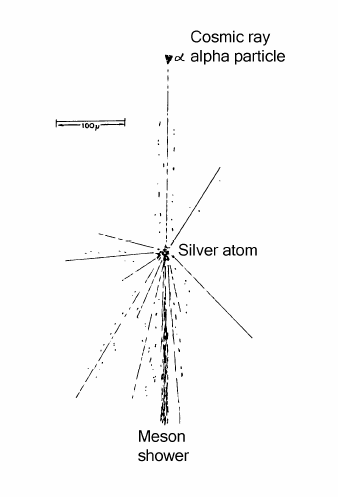 In a picture that contributed to his Nobel Prize in 1950, a photograph witnessed a high energy cosmic ray bullet smash into a target atomic nucleus ejecting a shower of 140 mesons which lived for less than a trillionth of a second before evaporating from mass back into energy. 9
In a picture that contributed to his Nobel Prize in 1950, a photograph witnessed a high energy cosmic ray bullet smash into a target atomic nucleus ejecting a shower of 140 mesons which lived for less than a trillionth of a second before evaporating from mass back into energy. 9
The important thing to appreciate from Powell’s ground breaking cosmic ray research is that inadvertently he had proved by experiment that mass is a form of movement. His experiment showed the mass of the mesons was formed out of the arrested motion of the cosmic ray particle. The vortex of energy shows how movement rather than material substance can be ‘contained’ as mass in those mesons.
Cosmic ray research was the beginning of high energy research. High energy research has disproved the material hypothesis beyond shadow of doubt. Einstein’s idea that energy, not material substance, underlies everything is proved again and again in high energy experiments.
Most secular scientists believe in a material reality and describing themselves as ‘skeptics’ take delight in explaining away non material realities. Now we realise they may be deluded. Materialism is a delusion caused by spin. The vortex of energy explains away all the properties of materiality as properties of spin.
Spin is a form of energy. Energy forced through a stable subatomic vortex, such as a proton, takes on the vortex form. But this is only transitional. Free of the ‘vortex mould’ the swirl of energy reverts to its original wave form and radiates away. This is what Powell witnessed in his cosmic ray photograph.
We live in a non-material world. Skeptic scientists are non material realities. They are nothing but a bunch of waves and vortices of energy. There is no substance to them at all! That goes for all of us. We are nothing but spin and the same applies to the planet Earth and the entire Universe!
In Western society most people believe the material dogma without question because we were indoctrinated as children that our world is substantial and we believed our teachers and continue to believe leading figures in philosophy, religion, politics and science.
Scientific materialism founded on the speculations of Democritus and other Greek philosophers is not based on sound scientific principles. It is more like religious faith. High energy research has proved that our world is formed not out of particles of material substance but particles of movement. The word energy means ‘movement within’. The subatomic vortex shows how the movement within everything can be contained in matter making it appear solid and substantial. Subatomic spin is the ultimate delusion.
The greatest enigma of modern physics is the transformation of energy into mass and mass into energy. The inability to understand nuclear energy, for example, originates from the material paradigm based on the doctrine of Democritus. Democritus’ idea that matter consists of atoms moving in a void of space and that nothing else is real led to the belief that energy is just the measure of the movement of atoms in space. This materialistic view of the universe, the classic bedrock of science, didn’t allow for atoms to flip into energy!
When Richard Feynman said “Of nuclear energy we have the formulas for that but not the fundamental understanding” he was expressing the lack of understanding of nuclear energy because of the material hypothesis. As Feynman himself said, “If in some cataclysm, all of scientific knowledge were to be destroyed, and only one sentence passed on to the next generation of creatures, what statement would contain the most information in the fewest words? I believe it is the atomic hypothesis… that all things are made of atoms – little particles that move around in perpetual motion.” 10
The Universe is energy. Energy is the movement out of which everything is formed, it is neither created nor destroyed, and it is divided into particles so the Universe is composed not so much of particles in perpetual motion as particles of perpetual motion.
In his book on worldviews, William Berkson said Albert Einstein was difficult to understand, not because of his theories and his mathematics but because of his worldview. Einstein contended matter and the field (light) are real but there is no substance in them.11 Einstein did not believe in material substance. In 1905 he predicted that mass is relative to the speed of light. He equated mass to the speed of light in E=mc2. The speed of light is a measure of movement. The transformation of the movement of the cosmic ray particle into the mass of mesons proved mass is a form of movement! That is why the mystics of the Vedas, the Chinese sages and Buddha taught there is nothing in our world but changes, processes and ceaseless activity. We call that energy.
To quote Fritjof Capra: “There is motion but there are, ultimately, no moving objects; there is activity but there are no actors; there are no dancers, there is only the dance… Like the Vedic seers, the Chinese sages saw the world in terms of flow and change, and thus gave the idea of a cosmic order an essentially dynamic connotation… The general picture emerging from Hinduism is one of an organic, growing and rhythmical moving cosmos; of a universe in which everything is fluid and ever changing, all static forms being maya, that is, existing only as illusory concepts. This last idea – the impermanence of all forms – is the starting point of Buddhism. The Buddha taught that all compounded things are impermanent’, and that all suffering in the world arises from our trying to cling to fixed forms – objects, people or ideas – instead of accepting the world as it moves and changes. The dynamic worldview lies thus at the very root of Buddhism.” 12
Eastern mystics were not influenced by the materialistic philosophy of the Greeks. They did not assume the existence of the ether or atoms. They recognised that underlying everything is the movement we now call energy.
Feynman said, “It is important to understand in physics today we have no idea what energy is.”10 Mystics have known for millennia what energy is and Yogis solved the mystery of how energy can be locked up in seemingly inert matter thousands of years before Einstein conceived of E=mc2 or Powell birthed high energy research.
It doesn’t matter if Yogic insights are considered unscientific or unsubstantial by skeptical scientists. They are used to develop the axioms of the new vortex theory and the axioms of a scientific theory do not have to be substantiated; they can be freely invented. The new vortex theory does not depend on the insight of mystics. Mystical insight is credited to put the record straight!
1. Satchidananda Sri Swami The Yoga Sutras of Patanjali Integral Yoga Publications (Sanskrit) 1992
2. Stiles Mukunda, Yoga Sutras of Patanjali Red Wheel/Weiser 2001
3. Ramacharaka Yogi, An Advanced Course in Yogi Philosophy Fowler
4. Thomson, W., Mathematical and Physical Papers 6 vols. 1841-1882
5. Maxwell James Clerk, Encyclopaedia Britannica, 1875
6. Thomson J.J., Treatise on the Motion of Vortex Rings University of Cambridge 1884
7. Feynman R. The Character of Physical Law, Penguin Books 1992
8. Einstein, Albert, Does the Inertia of a Body Depend Upon Its Energy Content? Annalen der Physik 1905
9. McKenzie A. E., A Second MKS Course in Electricity, Cambridge University Press 1968
10. Calder Nigel, Key to the Universe: A Report on the New Physics BBC Publications 1977
11. Berkson, William, Fields of Force: World Views from Faraday to Einstein, Rutledge & Kegan Paul 1974
12. Capra Fritjof., The Tao of Physics, Wildwood House, 1975 & The Turning Point, Fontana, 1983
Note on the ether: Light waves are transverse. Transverse waves require rigid, high tensile mediums to transmit them. The rigidity increases with velocity of the waves. Because of the high velocity of light the ‘frictionless’ ether, were it to exist, would have to be more rigid than steel. It is hard to imagine the Earth orbiting the Sun through a medium more solid than steel. (Richards et al, Modern University Physics, Addison Wesley 1973)
Excerpt from Vortex of Energy
Posted in Science For The New Agewith comments disabled.



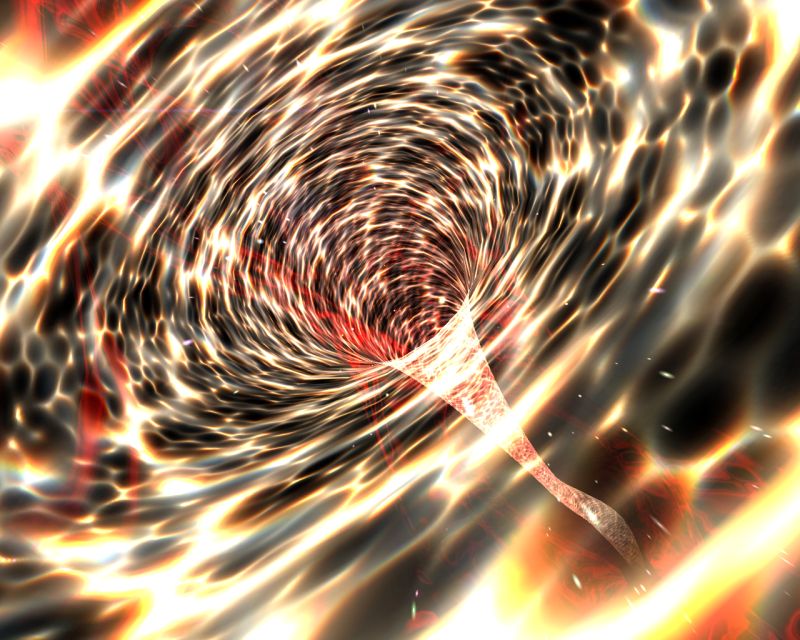
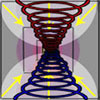

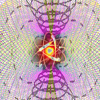
[…] David Ash: Vortex of Energy (http://www.unariunwisdom.com/vortex-of-energy/) […]